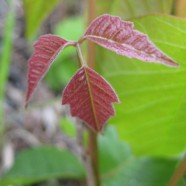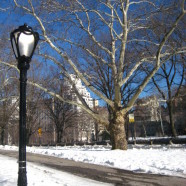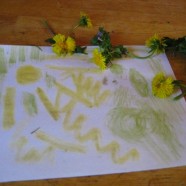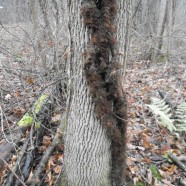Honey Locust: Defanged
Honey locust, in Manhattan’s Central Park, has thorns. Big thorns. Not just little prickers, great huge whomping thorns, six inches long and iron hard.
Read MoreWhat Does Poison Ivy Look Like in Spring?
What does poison ivy look like in spring? A little like a traffic light—red and shiny. Poison ivy’s first leaflets are garnet red, which slowly fades to green.
Read MoreLondon Plane Tree: East Meets West
London plane trees decorate streets all over the world. Hardy hybrids of American sycamore and oriental plane trees, they defy smog and traffic.
Read MorePrickly Pear: Handle With Care
Prickly pear cactus. A quiet, well-behaved plant, as house-plants go. These guys have been living meekly in their pots for more than twenty years—just getting taller and taller. They’re in an upstairs room, and I keep forgetting to water them, and every six months or so I go upstairs with a watering pot, fully expecting to find shriveled corpses. But prickly pear is a plant that’s hard to kill. This spring, I decided to take pity on the poor things and let them enjoy a pleasant summer soaking up the sun on the front porch. As I maneuvered one of the lanky plants down the stairs and out...
Read MoreNature’s Crayons
There’s a chemical which is found in every green plant–every tree, grass blade, bush, cactus, moss, rosebush, lettuce, whatever. It’s called chlorophyll, and it’s a pigment, actually, a green pigment which absorbs just the right wavelength of sunlight to jumpstart the complex chemical process whereby plants make food. Chlorophyll is the key to photosynthesis, enabling plants to magically transform air, sunlight, and water into sugars that nourish the plant and anything that eats it. Chlorophyll is, really, the basis of life on this planet. Chlorophyll is also the stuff that puts grass...
Read MorePoison Ivy: Hairy Vine
There are almost as many ways to climb trees as there are species of vines. Grapevines have curly tendrils that grab branches, while Virginia creepers use little suction-cups. Asian bittersweet corkscrews its way round and round the tree trunk. But poison ivy’s method of ascent is unique. Poison ivy gets to the top by growing thread-like rootlets all along the length of its stems. At first the rootlets appear as little patches that look like tufts of fuzzy hair. The furry roots secrete a glue-like substance which virtually cements the vine to tree or wall. As the main stem ages, more and...
Read More










Recent Comments